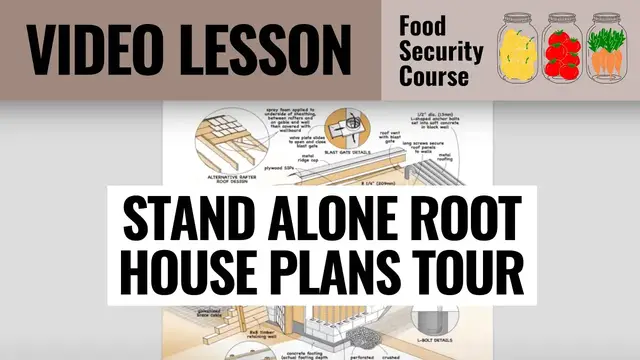MY ONLINE COURSES:
► My Cabin Building Course: https://bit.ly/36bRARX
► MIG Welding for the Home Workshop: https://bit.ly/3CGuUFv
► Woodworking for Beginners: https://bit.ly/3w6ZnLW
► How to Build a Deck: https://bit.ly/3i2LWV3
► Build Traditional Wood Cabinets: https://bit.ly/3JbLQ9v
► Renewable Energy for Your Home: https://bit.ly/3w9K4ls
► 3 Solar Energy Projects: https://bit.ly/3KLNUp9
READ MY POPULAR ARTICLES ABOUT:
► Polyurethane Finish - https://bit.ly/powerbuffing
► DIY Hoop House Plans - https://bit.ly/hoophouseplans
► Submersible Pump Installation - https://bit.ly/pumpinstallation
► Air-Drying Wood Tips - https://bit.ly/wooddrying
► How to Build a Table - https://bit.ly/tablebuilding
► How to Stain a Deck - https://bit.ly/deckstain
► Choosing Waterproof Outdoor Glue - https://bit.ly/exterioradhesives
► How To Build A Wheelchair Ramp - https://bit.ly/wheelchairrampplans
SUBSCRIBE: http://bit.ly/BLRchannel
Show More Show Less View Video Transcript
0:00
This video is your tour of the plans for building a standalone root cellar
0:06
So, this is kind of like the septic tank root cellar that I talk about in other parts of the course
0:12
but it's larger and more full-featured. So, essentially, you're building a small masonry structure covered by as much soil as possible
0:26
And in this case, I'm recommending the use of blocks. Blocks are handy because they're fairly thick
0:34
They're easy to build with, comparatively speaking. But you can also fill the cavities within the blocks and install reinforcing rod
0:44
which is what you see here. Because you want that wall to be strong and to be able to resist the inward pressure of soil
0:53
So, these are the reasons why blocks are a good choice. For those blocks that are going to remain visible after the root cellar is constructed
1:03
you might want to use some textured blocks. They look a little nicer
1:07
And if you see here, the soil stops here, and the block wall will remain visible here
1:13
and here as well, and then maybe a little bit up on the side, too
1:18
So, some sort of textured block works really well there. There's a whole lot going on in these plans
1:23
and I'm just going to go from one item to another and familiarize you with what's going on
1:30
And if you have any questions, please feel free to contact me through the course interface
1:35
because there's a lot going on here. If you actually want to build one of these, I'll ask you to send me some photos
1:42
We'll look at things like drainage and natural earth slope and things like that
1:49
Because you want to make sure you get this right. You're going to a lot of trouble
1:53
It's going to be a great resource, a great piece of infrastructure for your family food security
2:01
but you want to make sure you get it right, too. Starting here at the bottom right, you can see a cross-section of the bottom part of the wall
2:09
sitting on a footing. So, a footing is a wider area of, in this case, concrete that provides support for the wall
2:21
So, the 12-inch blocks that we're using here for the wall, that 12-inch width
2:28
might not be sufficient to support the root cellar on all soil conditions
2:32
So, that's why I'm recommending a footing here 6 inches thick, 24 inches wide
2:38
I don't know of any well-drained soil conditions where that's not going to work just fine for you
2:45
And then that's one thing to keep in mind here. Moisture is not something you want leaking into your root cellar
2:51
So, you're going to want to choose, as I said, a well-drained location
2:55
Ideally, in some sort of light soil that allows water to percolate through it easily
3:02
It's easier to build on light soil, too. So, just something to keep in mind
3:08
Here's the top view of the walls. This cellar design is roughly 8 feet wide and 12 feet long
3:15
There's nothing magic about that, but it's a good size. It's going to give you more room than a septic tank root cellar will
3:26
So, size is one of the reasons you'd want to go to this trouble of building
3:31
Here's the roof slope detail. In this case, in this design, the roof of this structure is not buried
3:41
It's a sloped roof and it's insulated. I'm recommending here structural insulated panels because you can get them for foundation use
3:53
So, they'll be well able to work properly on a structure that's close to the soil
4:01
So, you might get some more moisture wicking up here. The roof is essentially going to be just a block or two above soil level
4:09
So, there's going to be some splashing. You'll want to cover the edges of the roof with some sort of aluminum fascia
4:17
Do a nice job of it. But, in this case, I would recommend plywood sheathed structural insulated panels
4:27
That's what SIP stands for. And the plywood sheathing is the stuff that they would use for foundations
4:34
They use panels like this for foundations. It makes a great roof in this case
4:40
Over here in the plans, you've got a little detail about how to form the footings
4:47
So, some planks of wood, some stakes. It just forms a kind of a form and the concrete can be poured directly onto the soil
4:57
and held in place by these boards. And this is what you're going to get
5:01
That's what the footing looks like on the 3D plan. So, here we've got some drainage tile
5:09
A very good idea to put that in, even if you feel your site is well drained
5:14
Even if you feel your site is well drained, having the drainage tile there
5:18
It's a perforated plastic pipe, if you're not familiar with what it looks like
5:22
And it needs to slope away and empty out somewhat lower than the root cellar
5:29
And that's just added insurance that you're going to have no liquid water leaking into the cellar
5:35
And that wouldn't be a good thing if you did. To further improve the water resistance of the structure
5:41
it would be a great idea to put some self-sticking waterproof membrane on the outside of the blocks
5:46
And then also a dimpled drainage membrane. So, this is a plastic layer that has plastic dimples sticking out from it
5:57
And it creates a small vertical drainage channel. So, if water does get next to this membrane
6:07
it can trickle down without applying pressure to the wall. And it will go downwards instead of moving inwards into your wall
6:16
And connect with the drainage tile here, so that the water can leave without causing any trouble
6:23
In order to provide an anchoring surface for the roof, you're going to need to put on some pieces of wood
6:33
These are kind of like sill plates on a regular house. So, the wood you can see here and here would bolt down to the top of the wall
6:44
Using some elbow details like this, that works just fine. And in the case of the SIPS panels, because the panel will be rising up
6:54
leaving this top plate at an angle, you're going to need some sort of an angled piece of wood to match that
7:02
Just so that the panel is bearing on more than just the outside corner of this piece of wood
7:10
this top plate here, so that it has something wider to bear on
7:15
An alternative to the SIPS roof would be a rafter roof design
7:22
And in order for this to work, though, you have to do more than just put up some rafters
7:29
and some roof boards and some shingles on top. You're also going to need to insulate that
7:35
Without insulation, there's no hope that the root cellar is going to work
7:40
So, spray foam applied to the underside of the roof sheathing between the rafters
7:46
that's going to do a good job for you. You'd want to do the same sort of procedure here for the gable end walls
7:53
They're not very tall, but they can be done in SIPS panels like you see here
8:00
or they could be framed. And there would also need to be insulation put in between the frame members
8:09
in order to get that to work. Because the goal with a root cellar, as I've explained elsewhere in the course
8:16
is ideally you want 90-95% relative humidity for most things. In root crops especially
8:23
And then a temperature of just a little bit above freezing, a degree or two or three above freezing
8:30
So you're not going to be able to get anywhere near that sort of performance
8:36
without a well-insulated roof structure. The walls will be ameliorated by the soil
8:45
because the soil doesn't get too cold in the winter and it doesn't get too warm in the summer
8:49
But the roof you do need to pay special attention to
#Gardening & Landscaping
#Home Improvement
#Home Storage & Shelving
#Yard & Patio



